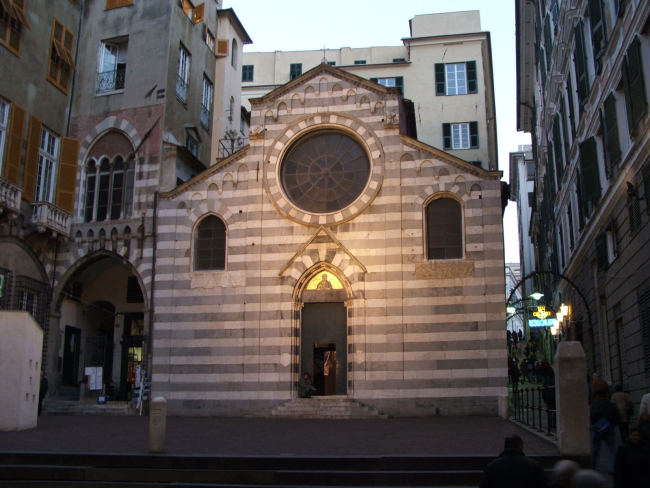San Matteo Church
San Matteo Church
The church and square of San Matteo are a journey window into another time; emerging from the corner of a “caruggio” the precious jewel box of the Doria family opens up. The colours, materials and the Gothic shapes of the palaces, square and the church envelop you and giving the impression that here time has stood still and that, at any moment, a figure in medieval clothes might look out from a loggia.
Visit
The facade of the church, with its characteristic black and white striped decoration, is divided into three parts by two fake columns, the facade itself is surmounted by a series of elegant small arches, its central part features a large rose window flanked by two smaller arched windows; San Matteo appears on the lunette of the entrance door, depicted on the golden background of a medieval mosaic; an Allegory of Autumn, a late Roman marble sarcophagus is repurposed to be an element of the façade, as can also be seen in the cathedral of San Lorenzo; while on the white marble stripes, inscriptions exalt the deeds of the Doria family.
The interior has three naves and offers a mix of splendid Renaissance decoration combined with Gothic architectural elements.
The need to demonstrate the enormous success of Andrea Doria required that the interior of the church had to be completely renovated in Renaissance style in the mid-sixteenth century, eliminating the separation between the nave and the transept and enriching it with decoration. Giovanni Angelo Montorsoli led the restructuring and decoration of the presbytery, the dome and the crypt below.
Along the naves there is a rich series of sixteenth-century frescoes and stuccoes, the work of Luca Cambiaso and Giovanni Battista Castello; also not to be missed are the paintings by, among others, Bernardo Castello, Andrea Semino and Silvio Cosini; as well as wooden sculptures by Anton Maria Maragliano. The crypt, under the high altar, houses the tomb of Andrea Doria, with statues, marble reliefs and the gilded stuccos by Giovanni Angelo Montorsoli.
Those with a taste for history, should note Andrea Doria’s sword and the marble “arks” bearing relics of saints Pelagius and Maximus, which Gaspare Spinola had moved from Istria to Genoa at the end of the fourteenth century. Music lovers will not miss the valuable Baroque pipe organ by Antonio Alari.
History
San Matteo (Saint Matthew) was a tax collector, as indeed were the Dorias, who for this reason chose him as their patron saint, in 1132 they consecrated the Romanesque church to him, the building had previously been a private chapel founded in 1125 by the Benedictine Martino Doria. At the end of the thirteenth century the church was completely restructured in the Gothic style and the facade was set back to align it with the magnificent “new” buildings that now framed the “family” square. At the beginning of the 14th century, the refined cloister was built on the side of the church, behind Palazzo di Branca Doria.
The square
The scenographic open space in front of the church, raised above the street, is surrounded by the magnificent palaces of the Dorias, which even after their sixteenth-century renovation maintained the painted facades and pointed arches of their original Gothic structure. In addition to Palazzo Branca Doria, already mentioned for the beautiful cloister attached to the church, but there is also Palazzo Lamba Doria, Palazzo Domenicaccio Doria, Palazzo Giorgio Doria and Checco Quartara which stands out, with one of the finest Renaissance doorways in Genoa.
In this square the sense of another time is overwhelming: you are immersed in the sequence of pointed arches, to which the horizontal texture of black and white bands responds, a purely Ligurian element made of white marble and black Promontory stone; and inevitably struck by the strength of the identity of "Borgo dei Doria", the nucleus of the monumental district owned by the family which, originally, was much larger.




